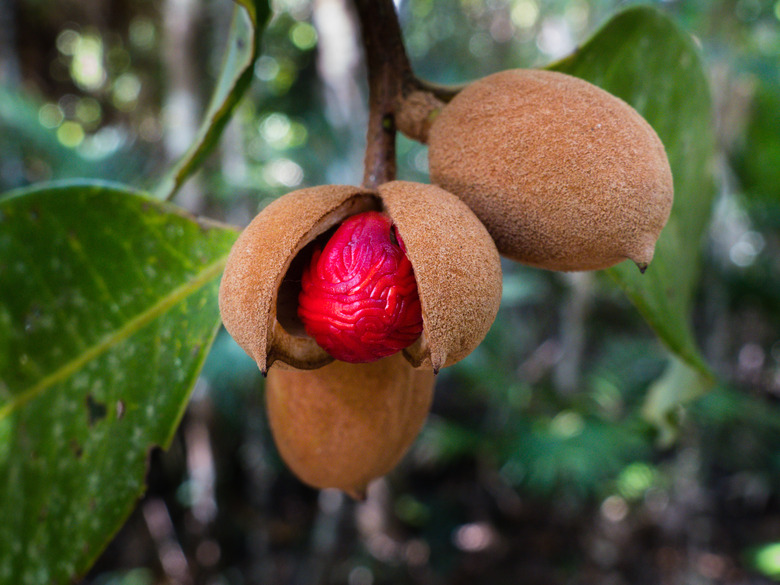How To Grow A Nutmeg Tree From Seed
We may receive a commission on purchases made from links.
Providing two spices from one seed (nutmeg and mace), the nutmeg tree (Myristica fragrans) is an aromatic evergreen that grows in most tropical countries. Hardy only in U.S. Department of Agriculture plant hardiness zones 11 and 12, this spreading tree grows 10 to 30 feet tall and bears cream-colored flowers followed by yellow, fleshy fruit similar to apricots. Ripe fruit splits open, revealing glossy, purple-brown seeds partially covered by scarlet skins, called arils.
Interested in growing your own nutmeg tree from seed? Here's what to know.
Tip
It's important to note that because of its limited perennial range in zones 11 and 12, U.S. gardeners cannot grow this tree outdoors year-round. It can only be grown in greenhouses that are heated during the winter, and its growing environment must mimic the humid atmosphere of its tropical native climate. Another consideration for greenhouse-grown trees is their mature height, which may reach 30 feet, although container-grown plants typically will not grow this large.
1. Separate Aril from Nutmeg Before Sowing
1. Separate Aril from Nutmeg Before Sowing
Separating nutmeg from its mace-producing aril improves germination rates. A spice used to flavor milk dishes, cookies, cakes, fruit pies, custards and punches, nutmeg is the purple-brown inner seed of the nutmeg tree fruit. Mace, which is an ingredient in savory dishes, ketchups and pickles, is made from the aril that covers the seed.
You should remove the aril before sowing nutmeg. To do so:
- Sanitize a small, sharp knife by wiping the blade with rubbing alcohol
- Cut the aril at its base it where it joins the nut.
- Peel it off, taking care not to damage the nut.
- Discard the aril or place it in a dry, sunny area for 10 to 15 days until it turns brown and dry, ready for grinding into mace.
2. Sow Nutmeg Seeds Promptly
2. Sow Nutmeg Seeds Promptly
Only fresh, moist nutmeg seeds germinate well. Unfortunately, nutmeg seeds dry out quickly. If left uncovered at room temperature, a nutmeg seed can lose its ability to sprout in as little as seven days. For best results, sow your nutmeg seeds promptly after harvest.
When immediate planting isn't possible, store the seeds from your nutmeg plant in sealed plastic bags in the refrigerator. There they will stay viable for up to 45 days. No matter when you're ready to plant, soak your nutmeg seeds for 24 hours in clean water first to increase moisture levels and raise germination rates.
After soaking your nutmeg seeds:
- Fill a 5-inch plant pot containing drainage holes with free-draining potting mix and sow the nutmeg 1 inch beneath the soil surface.
- Water the pot until water appears through the drainage holes, allow it to drain, and stand it in an area where temperatures are between 77 and 86 degrees Fahrenheit.
- Apply water regularly so the potting soil remains constantly moist but not sodden. Nutmeg seeds take one month or longer to sprout.
3. Water Young Nutmeg Trees Regularly
3. Water Young Nutmeg Trees Regularly
Mist your young nutmeg tree twice a day with clean water from a fine mist sprayer, coating the foliage but stopping before water drips from the plant. Water your young nutmeg tree regularly so the soil remains moist and allow the pot to drain thoroughly before returning it to its drip tray. Turn the tree 180 degrees every day to prevent it from leaning toward the light.
A young nutmeg tree thrives in a partially shaded but warm and humid environment. Place a newly germinated nutmeg tree in an indoor area that receives four to six hours of sunlight a day, such as a west-facing conservatory or windowsill.
4. Transplant Your Nutmeg Tree As Needed
4. Transplant Your Nutmeg Tree As Needed
Transplant your nutmeg tree into larger pots as it grows. A nutmeg tree is ready for transplanting into a larger pot when its roots fill the base of its current pot. Select a pot 2 inches wider with drainage holes and transfer your nutmeg tree into it, setting the plant so that the top layer of soil is 1 inch below the rim. Water your freshly transplanted nutmeg tree thoroughly and allow it to drain. Continue transplanting the nutmeg tree into larger pots each time it fills its current pot.
Tips on Propagation
Tips on Propagation
Nutmegs are dioecious, which means that each plant is either male or female and cannot fertilize itself. To get fruit from an indoor plant, you'll need to set your potted plant outside each spring or get two plants and pollinate them by hand.
You'll also need patience. Nutmeg trees don't begin to fruit until they're around five to eight years of age, and some nutmeg plants take even longer. Even when production begins, your nutmeg tree won't perform at its fruiting peak until it's around 25. It's worth the wait, however, since nutmeg trees produce fruit for 60 years or more.
